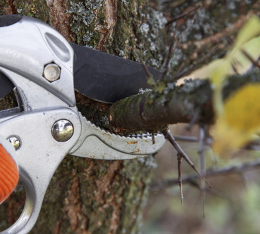An easy and manageable task, pruning oleander means you will get a strong, healthy plant with lots of bloom. Read the Buzzle article to learn the steps on how to prune oleander properly.

Oleanders, or
Nerium oleander are hardy evergreen trees which tend to survive in a variety of soils, even if it is of poor quality. If the pruning is done properly, it can be grown as a round shrub or grow as a tree. Basically, it is a showy plant with colorful flowers like orange, pink, white, yellow, and red. It can grow from 10 to 18 feet tall in USDA zones 9 through 11 and have the capability to bloom continuously in many zones. While taking proper care and pruning oleanders according to specific guidelines, you can definitely guarantee abundant blooms.
The perfect location for the plant is next to a walkway or the front yard, as it is considered to be an ornamental plant. Due to its rapid growth, scented flowers and tolerance to heat and drought, many people choose to plant it in their gardens. However, great care is required as oleanders are also one of the most poisonous house plants.
Pruning During Springtime
In order to carry out the entire process, little care and maintenance is required to keep its natural shape. But if you wish to give the plant a multi-stemmed or single-trunk shape, you would have to invest more time towards pruning. Despite what you choose, below we have instructions that will give you a complete look at how to go about the task.
- Always water the tree during drought conditions. Although it is resistant to droughts, watering the plant 1 to 2 inches each week while the dry spells are on, will maintain the tree's energy and production of flowers.
- Remember to remove the suckers from the base of tree. Suckers tend to appear when new growth is found at the bottom of the trunk and also in the ground (around the base of the tree). As soon as you see it sprouting, make sure to pluck it off. Or else, it will steal essential moisture and nutrients to grow properly.
- The ideal time for pruning is anywhere from September to early October. This encourages their growth in spring. While cutting the branches, do so just above the nodes that have like 3―4 leaves. The node of the branch is where the leaves will grow from the branch itself. Once you cut the area, new branches will grow from there and flowers will get a chance to develop at the end of these new branches.
- You can even follow heavy pruning as the plant is used to it. This means, while pruning more branches will make it grow faster and in abundance. While trimming, cut along the top and inside the bush as well to keep the shape. If you wish to grow it into a tree, only cut the lower branches, near the trunk. Plus, remove new growth along the bottom of the trunk, as soon as it shows signs of development.
- Organic fertilizer, once in early spring and again during early fall will assure the growth and flower production. Use balanced fertilizer which contains nitrogen, potassium and phosphorus and make sure to follow the directions given on the package. Or, you could follow the instructions for organic fertilizer recipe, and use the homemade fertilizer instead.
- Now, you also need to be careful with the caterpillars as the insects can wipe out the tree in less than 2 weeks. Snip the affected leaves and stems off that are present with caterpillars. You can also pick it with hands, place in plastic bag, seal it and keep in the freezer for about 24 hours. You can also use pesticides which contain bacillus thuringiensis. This will help treat caterpillars on tall trees.
As all parts of the plant are poisonous, make sure you wash your hands properly after pruning the oleanders. Discard whatever you cut in disposable bags, instead of burning it (the smoke is toxic). Help the trees grow in any desired shape you want, and keep the beauty of this ornamental plant alive.






 Oleanders, or Nerium oleander are hardy evergreen trees which tend to survive in a variety of soils, even if it is of poor quality. If the pruning is done properly, it can be grown as a round shrub or grow as a tree. Basically, it is a showy plant with colorful flowers like orange, pink, white, yellow, and red. It can grow from 10 to 18 feet tall in USDA zones 9 through 11 and have the capability to bloom continuously in many zones. While taking proper care and pruning oleanders according to specific guidelines, you can definitely guarantee abundant blooms.
Oleanders, or Nerium oleander are hardy evergreen trees which tend to survive in a variety of soils, even if it is of poor quality. If the pruning is done properly, it can be grown as a round shrub or grow as a tree. Basically, it is a showy plant with colorful flowers like orange, pink, white, yellow, and red. It can grow from 10 to 18 feet tall in USDA zones 9 through 11 and have the capability to bloom continuously in many zones. While taking proper care and pruning oleanders according to specific guidelines, you can definitely guarantee abundant blooms.